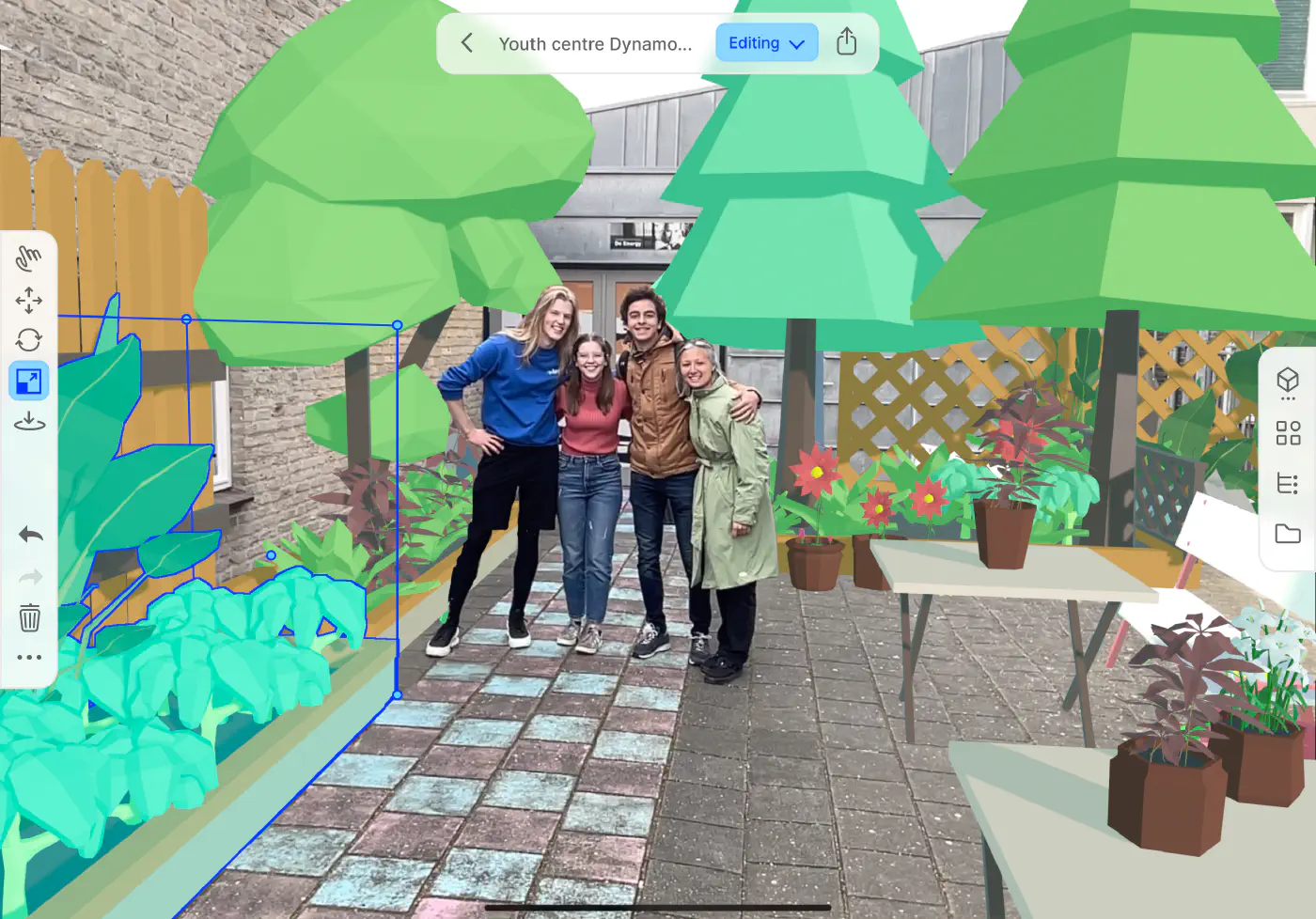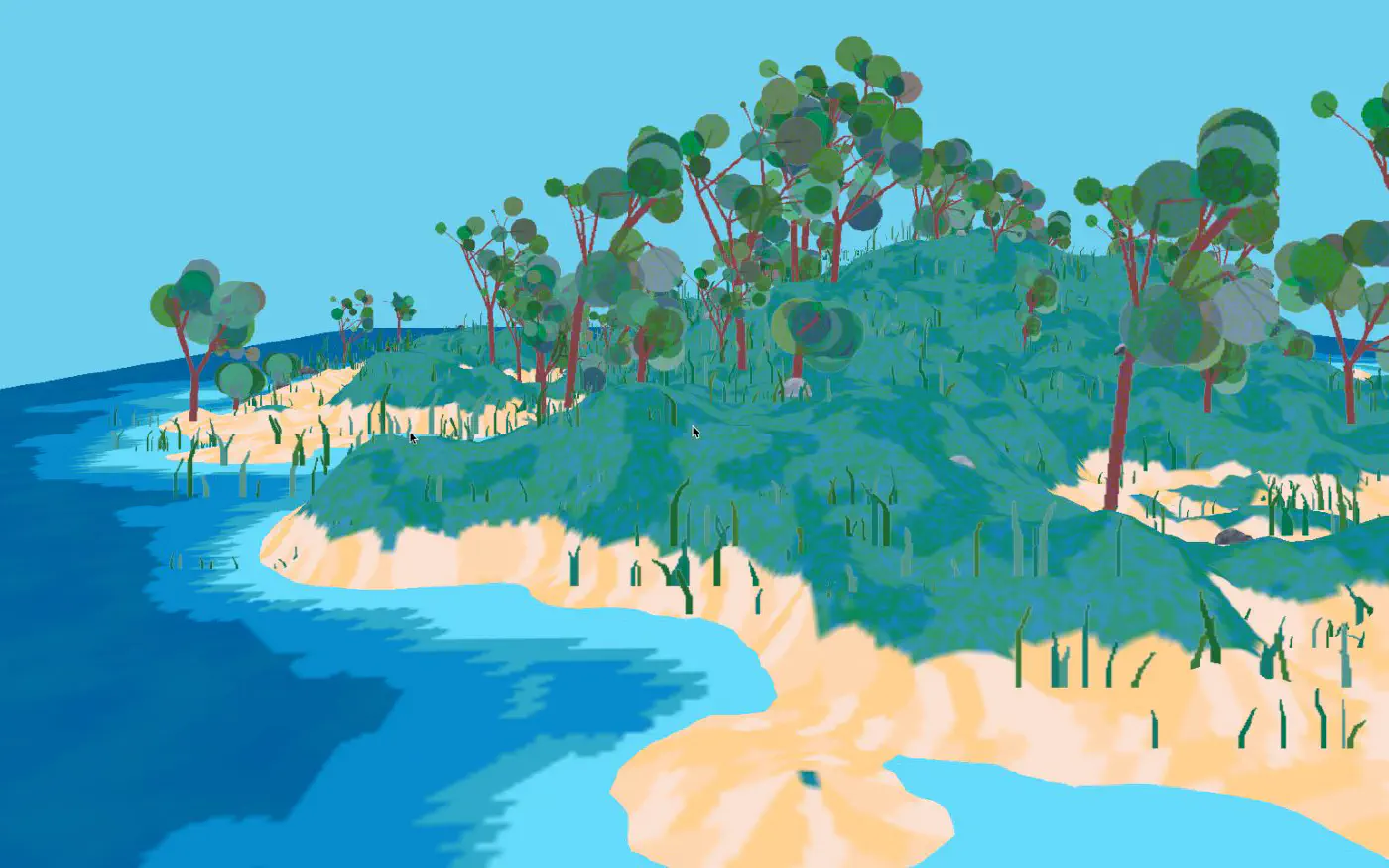Interactive AR / VR experiences for the Ministry of Defence (Netherlands)
12 August 2021
Tags: AR-VR
The Ministry of Defence Netherlands hired me to build an interactive VR experience for for a large scale construction project — the renovation of the maintenance workshop of the land forces — called "Technology Center Land". As a 21-year-old in university, with no formal background in architecture.

But how does one even land such a project?1
Pitching the world #
For that we have to go back to half a year prior to the start of the project, when I joined the university’s entrepreneurial competition: Ambitious and inevitably naive students pitch their groundbreaking ideas and business plans to a jury of companies, without much regard for technical feasibility.
I was one of those students, and was fully immersed in the idea of building a startup that would revolutionise augmented reality. At the software and hardware level. A digital layer over reality, how amazing would that be? You could show how the world looked in the past, or how we want it to look in the future! A true time-travel device, with infinite creative potential.
A true time-travel device, with infinite creative potential.
This was during Covid, so there I was, sitting behind my laptop in my room, pitching to three companies. My first pitch went as great as you would expect; I forgot half of my pitch, stumbled over my words and managed to talk myself into a corner. After a similar second pitch, the schedule read “Ministry of Defence”. I imagined a cynical, authoritarian man in uniform and prepared for the worst. But I was pleasantly surprised by a lovely woman with a soothing accent.
She listened with joy to what I had to say, so I decided go off script and talk from my personal passion. What I wanted to build and why. As there was no real product I sold — merely a vision, I was expecting no follow-up. But she saw potential and asked if I could build what I was describing for a project of theirs.
The never-ending project #
That project was Project Smart Base — a project set up by the Ministry of Defence at an old military training ground, with the goal of strengthening collaboration with the industry™, and providing a test ground for new military equipment. It was not built yet, and I was brought in to create an attractive visualisation for what could become.
As I was still invested in the idea of building an augmented reality startup, I planned a piece of software for presenting their plans on-site, at world-scale, using AR headsets and mobile devices; PowerPoint, but 3D and situated in the real world.
Evidently, I did not yet have proper self control when it came to feature creep and over-ambition. The concepts of MVPs (Minimum Viable Product) and KISS (Keep it simple, stupid!) had not fully settled in my brain. Because who enters the field of software development to build something that’s just enough? Needless to say, deliverables were not clearly defined and deadlines got pushed back indefinitely.
Life’s short, don’t spend three full days modelling trees.
Throughout the project I did work really hard. I learned about the importance of a good asset production pipeline, how much time 3D modelling truly takes, and that you should never be afraid of buying assets - especially when it comes to foliage or supporting assets. Your time is worth more than what you pay for an asset on TurboSquid, CGTrader or the Unity Asset Store. A client doesn’t pay for your hours spent in Blender, they pay for an end result that looks good. Life’s short, don’t spend three full days modelling trees.


Getting poached, internally #
The person at the Ministry of Defence who recruited me worked on two projects simultaneously. They showed my work to one of the head responsibles of that other project, who on their turn asked “Could you do this for us too?”. My pride and then still prevalent inability to say no to a puppy-eyed colonel resulted in a resounding “yes, I would love to”.
So there I was, poached internally to create VR experiences for a large scale construction project called “Technology Center Land” — the renovation of the maintenance workshop of the land forces.
I wrote a project proposal and quotation, clearly defined sub-deliverables, including the amount of revisions and no focus on clever software solutions. I had learned from my mistakes!
I had to build a fully realistic VR experience of a building that was not designed yet.
One peculiar detail was that I got involved in the project before any architect. So, I had to build a fully realistic VR experience of a building that was not designed yet. The only information that existed were the current facilities, meetings with the project responsibles, and a Program of Requirements (glorified excel spreadsheets that describe all spaces comprising the building). So I had to learn a plethora of architecture and real estate development jargon.
In order to gather enough context and data, I went on-site countless times to take pictures as reference material, got drone footage taken and got guided tours through the existing facilities. The young boy in me was thrilled. Military vehicles are majestical, brute pieces of technology. True displays of power. Only up close I could appreciate just how big these vehicles were. They reminded me of Thunderbirds vehicles, a British TV-series I watched endlessly as a kid.2

Real-time challenges #
But the excitement quickly turned into having to work incredibly hard.
A big challenge of the project was that the experiences had to run locally on Meta Quest 2 devices. Real-time lighting, high quality foliage and buying high-poly 3D models of the military vehicles were out of the picture.
So I did what every sane person would do. I modelled almost the entire thing by hand to stay within the polygon budget; the vehicles, the environment and specialised equipment. Only using specifications of the vehicles, measurements, sparse documents and photographed reference material.

The Quest 2 is not a powerful device. In combination with the requirement for a high resolution and high refresh rate, there’s no spare processing power for ambient lighting solutions or more than one measly directional light. So, I had to resort to light baking. A wonderful approach, but be warned! This excruciating process will make you lose sleep.

Imagine: You have a VR demonstration for the Ministry of Defence at 9:00AM next morning, and you’re still adding a couple changes to the model past midnight. The list of requested changes from last meeting is getting shorter; the end is in sight. Now all you need to do is re-render all the lighting. But you have to wait an hour for it to finish. You build the experience to your device… only to realise one 3D model accidentally got misplaced. So you, cursing your way through this process — as that is the third time it has happened this night — click bake lighting again.
You put on dance music to stay awake. It’s 4:00AM now and the birds have started singing. Through their calls, you can hear them laughing at you. Why did you do this at the last possible time? Some people are already going to work. And you’re here sacrificing your health because you’re working hard, not smart.
Luckily, I survived. It turns out you can sleep during the day when you come back from a meeting. I wouldn’t put it in a “day in the life”-motivational video, but I managed to get through the first two VR experience-deliverables this way.
Designing my own building — the “Teletubbies hill” #
The highlight of the project came when the project lead gave me the creative freedom to explore a building concept that would integrate fully in nature, tapping into the identity of the Ministry of Defence; innovative, robust and camouflaged.
Internally, it got dubbed the “Teletubbies hill”, and although I loved designing it, I’m convinced once the real architects and structural engineers come in, they’ll explain all the reasons why this building cannot and will never be built.
The design of the building started rather mundane, by translating the Program of Requirements into a two-story floor plan and translating that on its turn into a 3D model.

As a true virtual reality aficionado, I decided to incorporate virtual reality in the design process. Having no experience with “proper” methodologies for designing a building using maquettes, sketches or specialised software, VR has the lowest barrier of entry for me to create something that looks good, in a short amount of time — thus affording multiple iterations in only four hours of Gravity Sketching.

But how do you translate such a sketch to a world-scale immersive VR experience? You guessed it: with a lot of work, and all by hand using Blender and Unity.



The finish line #
After half a year of working until 4:00AM to wait for light baking, learning architecture and real estate development jargon and five iterations for each of the sub-deliverables later, the project was done. Demo time!
In the end, the project comprises three sub-deliverables, each one being a separate VR experience for Meta Quest 2:
- System restoration for the Boxer vehicle: An improved workshop for the mechanics to work on the Boxer vehicle
- System restoration for the Fennek and Bushmaster vehicle: A combined workshop for both the Fennek vehicle and the Bushmaster vehicle with a light, spacious design. Testing out a new approach for lifting vehicles in the workshop.
- Innovation and Expertise Centre Conservation Land: A facility separate to the main building focused on innovation and modernising existing vehicles.
Together with the project from the Ministry of Defence, I demoed the newly designed workspaces to the mechanics that work at the current facility. I even had the opportunity at a certain time to demo my work to the head of the land forces! Imagine being in a meeting with the head of the land forces, who is in full uniform, and somewhat clumsily putting a VR headset on his head with your experience. I was even wearing something wildly inappropriate; a white tanktop, sports shorts over a legging, sneakers and colourful socks. I was both proud, scared and amused at the whole ordeal.

Imagine being in a meeting with the head of the land forces, who is in full uniform, and somewhat clumsily putting a VR headset on his head with your experience.
All in all, I could not have wished for a better learning experience, even with all its ups and downs, as it forced me to grow up much quicker than I thought I had signed up for.

To conclude, I would like to leave you with this quote:
There are two types of people: Those who think VR will change the world — and those who haven’t tried it yet.

